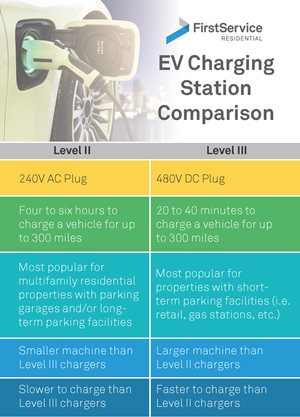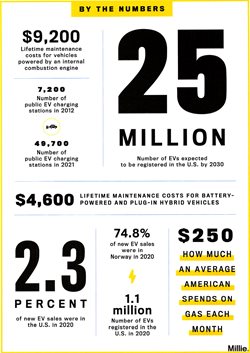Residential EV Charging Stations: Benefits & Incentives for Multifamily Buildings
Times are changing. Electric vehicle (EV) charging stations are now a necessary amenity for New York City condo, co-op and rental properties. Watch our webinar to learn from our experts about the ins and outs of EV charging stations, how installation can set your property apart from competing buildings, and incentive opportunities.
As more New Yorkers make the switch from gasoline engine to electric-powered vehicles, boards and building owners have a unique opportunity to capitalize on market trends by investing in electric vehicle (EV) charging stations. These charging stations can be a major selling point for prospective owners, shareholders and residents considering occupancy in a building when marketed as an amenity.
While construction and installation costs for EV chargers can be quite high, NYSERDA and Con Edison offer incentive programs for multifamily residential buildings in New York City to help offset the initial investment. In some cases, the incentives will cover 100% of project costs.
FirstService Residential recommends that all boards and building owners consider the installation of EV charging stations, especially because funding behind the Con Edison and NYSERDA incentive programs is finite and will soon be exhausted.
Con Edison’s PowerReady Electric Vehicle Charging Station Infrastructure Incentive Program
The goal of Con Edison’s EV PowerReady Infrastructure Incentive Program (formerly known as the “Make-Ready” Program) is to support the installation of infrastructure and equipment necessary to encourage the increased presence of EVs in the New York City area. The program launched in July 2020 with $235 million in financial backing to provide cash incentives that offset the upfront costs of constructing and installing charging stations.As of today, the state has not announced plans to increase the program’s funding which is awarded on a first-come, first-served basis. We recommended that boards and building owners begin the application process now before program funds are depleted.
If a building installed or started construction on an EV charging station after July 16, 2020, retroactive rebates are available.
Our energy experts were recently joined by Con Edison to discuss the intricacies of the PowerReady incentive program. Watch highlights from the webinar below or click here to view the full presentation.
Which buildings are eligible for the PowerReady Incentive Program?
All building owners, developers and residential boards can apply for the PowerReady Incentive Program. Limitations primarily apply to the type of hardware, public accessibility, the contractor or vendor selected for installation, and the number of plugs installed at the property. It is also likely that installation of EV chargers will be infeasible for properties without an enclosed parking structure or a surface level parking lot.Buildings that are located in a designated “Disadvantaged Community” may be eligible for greater incentives. This designation includes low and moderate-income communities and “environmental justice areas” that are disproportionately burdened by fossil fuel pollution, poor air quality and the presence of hazardous wastes.
Click here for an interactive map to see if your property is located within a Disadvantaged Community.
What costs are covered as part of the PowerReady Incentive Program?
The PowerReady incentives can reduce average project costs for a two-charger installation from $13,600 to $2,800, but only for specific categories of equipment and infrastructure.- Utility Electric Infrastructure Needed to Connect and Serve a New EV Charger: This may include traditional distribution infrastructure such as step-down transformers, overhead service lines and utility meters that will continue to be owned and operated by the utility.
- Customer-Side Infrastructure: This includes EV equipment or infrastructure necessary to make a multifamily property ready to install an EV charger. Types of electric infrastructure may include conductors, trenching, and panels needed for the EV charging station.
 Which plugs and chargers are eligible for incentives?
Which plugs and chargers are eligible for incentives?
Like most consumer products, there are a multitude of EV charging station manufacturers. While the program does not specify a list of required manufacturers, the guidelines do specify level two and level three charging stations as minimum criteria. The project is also required to yield a minimum of two plugs and can be scaled-up to cover a maximum of ten plugs.Which components are excluded from the PowerReady Incentive Program?
- EV charging devices
- Software required for users to activate the charger and pay for their session
- Signage
- Bollards
- Routine maintenance
- Associated hardware (power blocks, modules, mounting hardware, energy storage devices, etc.)
Will the EV chargers negatively impact a building’s energy grade, score and potential fines related to Local Law 97?
There’s no debate that EV charging stations will increase a building’s overall energy use, just one metric that impacts a building energy score, letter grade and carbon footprint. The city is currently considering plans to subtract energy consumption attributed to EV charging stations from the building’s total metered consumption. There is no word yet on how buildings can participate in the plan, whether facility upgrades will be needed, nor a timeline for when the plan will be released.Which vendors and contractors are boards and building owners permitted to work with on EV charging station projects?
To qualify for available incentives, all projects must be completed by a vendor listed in Con Edison’s approved contractor database. Boards and owners interested in participating in the PowerReady Program can begin the application process, here. Keep in mind that the application process can be quite complex for first-time users. FirstService Residential and its energy advisory affiliate, FirstService Energy, are prepared to help boards and building owners capture the maximum allowable incentives.For more information, contact FirstService Energy today.
The PowerReady program can be stacked with other New York State incentive programs for additional savings.
- New York State Tax Credit for Public and Workplace Charging: A tax credit of up to $5,000 for the purchase and installation of an electric vehicle charging station through the end of 2022
- New York State Energy Research Development Authority Charge Ready NY: A $4,000 rebate for each Level 2 charging port you install at your public parking facility, workplace, or multifamily apartment building
- New York State Municipal Zero-emission Vehicle (ZEV) Rebate and Infrastructure Grants: Provides grants to cities, towns, villages, and counties (including New York City boroughs) to purchase electric vehicle supply equipment for public use. The maximum award for any facility is $250,000
Working with FirstService Energy | Energy Management & Advisory Affiliate of FirstService Residential
 FirstService Residential and FirstService Energy are here to help boards and building owners make the best possible investments in sustainability upgrades and resources. FirstService Energy offers boards and building owners a turnkey service making it easier to enroll in all available incentive programs. This includes administrative tasks, aggregation of building-specific stats and historical data, and verification that preferred contractors are properly registered to complete installation and construction of the charging station.
FirstService Residential and FirstService Energy are here to help boards and building owners make the best possible investments in sustainability upgrades and resources. FirstService Energy offers boards and building owners a turnkey service making it easier to enroll in all available incentive programs. This includes administrative tasks, aggregation of building-specific stats and historical data, and verification that preferred contractors are properly registered to complete installation and construction of the charging station.Common challenges boards and owners may experience when installing EV charging stations:
Challenge: Lack of available power to serve charging stationsSolution: Service upgrades and necessary utility side work covered under Con Edison’s PowerReady Incentive program
Challenge: Lack of space in parking garages
Solution: Compact, wall-mounted charging stations with accessories like retractable cords
Challenge: Lack of cash to pay for the project
Solution: Through funding from NYSERDA and Con Edison, boards and building owners can offset up to 100% of costs related to hardware and infrastructure. To keep project costs down, the charging stations should be installed as close as possible to the energy source.
Properly vetting a contractor’s insurance is also critical. Some insurance policies contain exclusions that make the coverage essentially useless. FirstService Residential screens all contractors and vendors that service our managed properties to verify valid trade licenses and to ferret out any exclusions that would disqualify the company from rendering services in the building.
Contact FirstService Energy today for more information on how our energy experts can help your property achieve its efficiency goals.
*Image courtesy of Millie.us